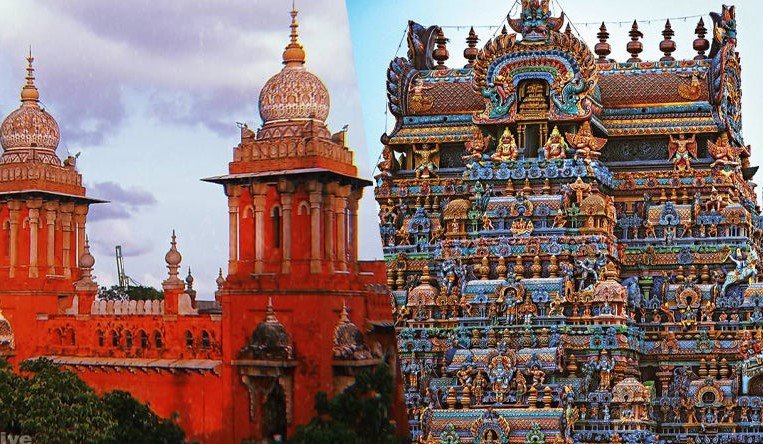Madras High Court Orders Temple Lands To Remain With Temples, Bans State Govt From Looting Temple Lands & Funds. Issues 75 Directions To Preserve & Maintain Ancient Hindu Temples


The Madras High Court on Monday, pronounced a far reaching judgement in which it issued 75 directions to the State Government to preserve and maintain properly ancient temples and monuments in Tamil Nadu.
The Court issued elaborate directions which could lead to sweeping reforms in the administration of temples under the HR&CE Act (Hindu Religious & Charitable Endowments Act)
A Division Bench of Justices R Mahadevan and PD Audikesavulu in its 224 pages judgement scathingly stated that the HR&CE and Archeology department are not fulfilling their duties to preserve and maintain properly ancient temples and idols despite receiving huge incomes from major temples. The Court remarked, “It is startling to find that the HR&CE department with all its income from major temples has not been able to maintain historical temples and safeguard the idols, which in market, have antique value based on their age… Many temples constructed at least 2000 years ago or much before, recognized by UNESCO, are in ruins. Neither the Archeology Department nor the HR&CE Department has shown interest to identify and protect them. This has also come to the advantage of the miscreants, who have laid their hands on the Idols”.
The Court also strongly observed, “…the custodians of grand and antique temples and antique temples and ancient monuments are least bothered and the conservation of our valuable heritage is deteriorating not due to any natural calamity or catastrophe, but due to reckless administration and maintenance under the guise of renovation.”
The Court ordered that the temple lands must always remain with temples and not be alienated by the State Govt or HR&CE should not alienate or give away such lands contrary to the wish of the donors.
The Court also observed that the ‘public purpose’ theory cannot be invoked for government acquisitions as the interests of the religious community always rests with such lands.
The Court ordered the immediate removal of encroachments and illegal constructions on temple lands, archeological sites and protected lands. The Court also oredered that appropriate actions must be taken on erring officials under the central or state departments and the HR&CE department for not removing the encroachments within the period of eight weeks on expiry of the time given.
The Court also directed to take stock of leaseholds and encroachments over temple lands and take immediate steps for recovery of rent arrears, eviction of defaulters and encroachers. It directed that a list of defaulters with arrears due from them must be prepared within six weeks and must be published in the website.
The Court directed that the Temple funds must be first utilised only for the maintenance and upkeep for those temples.
The Court said, “The funds of the temples shall first be utilized for the maintenance of temples, conducting temple festivals, payment to its staff including the archakas, oduvars, musicians, folklore and drama artists. In case of surplus funds the same shall be utilized for attending the repair and maintenance of other temples in the state as specified under the HR&CE ACT & Rules framed there under and for propaganda of the tenets of all or any of the religious institutions under the HR&CE Act”.
The Court also directed the HR&CE for proper audit of temple assets.
Importantly,the Court directed the formation of a Special Tribunal under the HR&CE Act to exclusively deal with matters relating to temple such as disputes on religious affairs, culture, tradition, heritage, inams and recovery of pending rent, validity of lease, illegal encroachment and mutts lands issues”.
Such a Tribunal is to be headed by the Working or Retired District Judge as Chairman with two or more members of the Subordinate Judicial Officers with the jurisdiction to decide the nature and status of the Religious Institutions, privileges and performance of rituals and poojas in all the religious institutions and their properties and the right of worshippers by conducting the cases like a Civil Court within a period of six months.
The bench directed to set up a high level committee to review the HR&CE Act every three years to make necessary amendments incorporating all penal provisions under IPC and procedures under Cr. PC to cover all illegal acts done in respect of temples for proper actions. It should also be amended to incorporate the National Conservation Policy and International Charters regarding conservation of monuments.
The High Court also directed the constitution of a Heritage Commission of 17 members within 2 months and declared that no structural alteration or repair of any monument, temple, idol, sculpture or murals notified either under the State Act or Central Act can take place without the sanction of the Commission.
It also directed the HR&CE department website to display the number of idols stolen, the number retrieved and the status of investigation. The bench observed the dire need of utilising advanced technology for protecting ancient cultural heritage and monuments.
The Bench also directed to declare all structures aged more than 100 years including temples, temple tanks, mutts, temple chariots, jewels, art, artefacts and sacred grooves etc., including private denomination temples as national monuments within immediate effect.
Notably, the order was passed on a suo motu public interest litigation taken up by court on the basis of a letter to editor published in The Hindu titled, “The Silent Burial” on January 8th 2015. The suo motu case was taken up by the then Madras High Court Chief Justice, Sanjay Kishan Kaul. A bunch of other PILs were also tagged along with this case which were filed later.
News input and image source:https://livelaw.in/top-stories/temple-lands-funds-madras-high-court-hrce-dept-ancient-monouments-175450
DISCLAIMER: The author is solely responsible for the views expressed in this article. The author carries the responsibility for citing and/or licensing of images utilized within the text.

